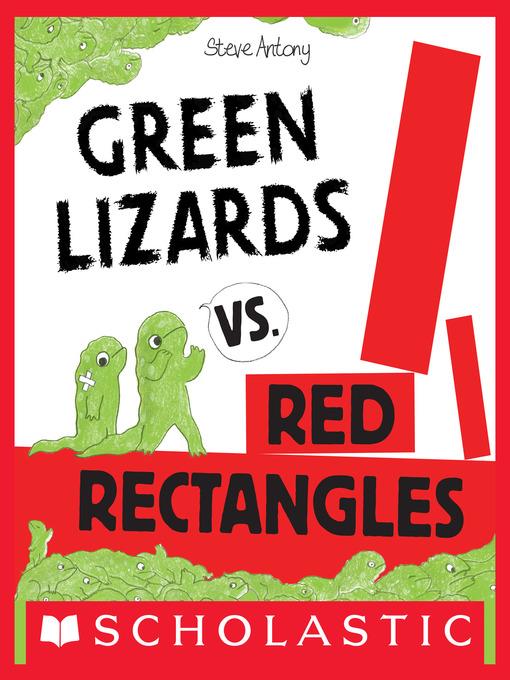
Green Lizards vs. Red Rectangles
فرمت کتاب
ebook
تاریخ انتشار
2015
Reading Level
0-1
ATOS
2.2
Interest Level
K-3(LG)
نویسنده
Steve Antonyناشر
Scholastic Inc.شابک
9780545913263
کتاب های مرتبط
- اطلاعات
- نقد و بررسی
- دیدگاه کاربران
نقد و بررسی

August 17, 2015
In the spirit of Dr. Seuss’s The Butter Battle Book, Antony (The Queen’s Hat) stages an absurdist face-off between an army of small, pea-green lizards and an opposing force of crisp, red rectangles of every shape and size. It’s an unlikely, even nonsensical matchup (almost animal vs. mineral), and that’s a large part of the book’s strength—this is not a war that ends with a realization along the lines of “hey, we’re the same underneath it all.” The combat reveals that both sides have their strengths: “the red rectangles were smart” (they attempt to encircle the lizards in a fencelike prison), while “the green lizards were strong” (they overwhelm the rectangles with their sheer, swarming numbers). Mid-battle, one lizard shouts, “What are we fighting for?” though his question goes unanswered after he is unceremoniously squashed. Luckily, the exhausted combatants find a way to coexist by book’s end, as the rectangles transform themselves into an urban dwelling for the lizards—a solution that acknowledges and celebrates difference, rather than trying to ignore or gloss over it. Ages 3–5.

August 15, 2015
The green lizards and the red rectangles are at war, but neither can defeat the other. Antony tackles war and peace in his latest picture book. The hand-drawn green lizards may look soft and huggable, but they have strength in numbers. The shiny red rectangles, with their stiff, sharp edges, are much too smart for the lizards. The two are evenly matched yet continue to fight. When one lone lizard bravely questions why they are fighting, he's crushed by a red rectangle. Their biggest battle yet ensues until a tiny rectangle calls for a truce. Soon the opposing sides find a creative way to live in peace. Antony's use of only two colors in his illustrations creates a bold contrast between the two adversaries. The juxtaposition of the monolithic, overlapping rectangles next to the small, individually drawn lizards heightens their differences. Inventive compositions provide variety and neatly evoke the chaos of war. Antony cleverly uses these same elements to illustrate the rivals' reconciliation. Young readers will enjoy the push and pull of the lizards and rectangles' battles and delight in their clever solution, though they will wonder why the lizards and rectangles were fighting in the first place. A visually entertaining story of war and peace. (Picture book. 3-5)
COPYRIGHT(2015) Kirkus Reviews, ALL RIGHTS RESERVED.

September 1, 2015
K-Gr 2-The outrageous notion of Green Lizards battling Red Rectangles is the hilariously far-fetched subject of this unusual story about what happens when two very different groups, one animate and the other inanimate, wage war against each other. Each side has special talents in their favor: the Red Rectangles are smart, and the Green Lizards are strong. When a single Lizard is brave enough to ask the obvious question "WHAT ARE WE FIGHTING FOR?" he is mercilessly squashed by a particularly long rectangle. This leads to the biggest war ever, until everyone learns to coexist peacefully. Vibrant greens and reds, the single two colors in the book, haphazardly explode off pages that are bare white. The small, oddly shaped Lizards look like the kind of sketches that a grade school student might doodle onto the margins of his notebook. The Lizard on the cover of the book, defiantly glaring at his red opponent with raised fists, is the best of the bunch. The overall moral of the story is as simply told as the illustrations and should leave an impression on young readers: there is never a good reason for fighting over differences, and living peacefully together is always the best approach. Overall, this is a unique way of presenting the topic of harmony and cooperation in elementary classrooms. Antony's clever book begs for a sequel; perhaps "Pink Dinosaurs vs. Blue Circles"? Why not ask children to name two other potential opponents? VERDICT A unique picture book with a thought-provoking message that will undoubtedly appeal to a storytime crowd.-Etta Anton, Yeshiva of Central Queens, NY
Copyright 2015 School Library Journal, LLC Used with permission.

























دیدگاه کاربران